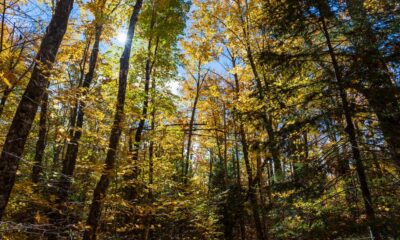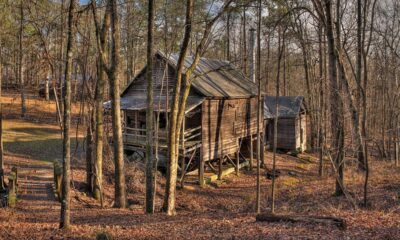Colorado
The 1893 silver crash left Colorado mining towns for dead – but nine steam engines kept them alive
Published
3 weeks agoon

The 1893 Silver Crash and Railroad Rescue
The Cumbres & Toltec Railroad once meant life or death for mining towns in Colorado’s San Juan Mountains.
Built in 1880, it soon helped Silverton double in size to 2,000 people while the mining district hit $1 million in yearly output. Then came the crash.
When President Cleveland killed the Silver Purchase Act in 1893, prices fell by a third and over 9,500 Colorado mining jobs vanished overnight.
For decades the line hung on, but by 1968 the railroad filed to shut down for good. In a last-ditch push, locals and train buffs joined forces to save this historic route.
Today, the same tracks that once carried silver fortunes now carry visitors through some of America’s most stunning mountain scenery.

Miners Dug Deep Hopes When Railroad Construction Began
The Denver & Rio Grande Western Railroad started work in 1880 on their San Juan Extension to reach Colorado’s booming silver mines.
They built narrow gauge track with just 3 feet between rails instead of the standard 4 feet 8 inches. This smart move helped them handle tight mountain turns while saving money.
Workers laid 64 miles of track from Antonito, Colorado to Chama, New Mexico through some of the West’s toughest land.
They finished the line to Chama on New Year’s Eve 1880 after drilling two tunnels and building a bridge over a 600-foot gorge.

Silver Struck Gold For Mountain Communities
The railroad quickly became vital to the San Juan mining area. Silver output hit $1 million yearly by 1885, then doubled to over $2 million in the 1890s.
Silverton grew to 2,000 people after the train arrived in 1882.
The narrow tracks carried tons of silver ore down from the mountains while bringing up everything families needed to live.
Store owners in small mountain towns could now stock fresh food, clothing, and household goods from Denver and beyond. The railroad linked once-cut-off mining camps where people built lasting homes.

Daily Trains Meant Survival For Isolated Families
Mining families counted on the railroad for almost everything they needed to live in the harsh mountains.
The daily train whistle meant mail from loved ones, medicine for the sick, food for the table, and tools for the mines. Kids got to go to proper schools thanks to supplies and teachers brought in by rail.
During winter when snow blocked mountain roads, the railroad kept towns connected to the outside world. Many families lived in spots with no roads at all, making the train their only link to the wider world.

Government Silver Purchases Filled Train Cars
Congress passed the Sherman Silver Purchase Act on July 14, 1890, forcing the government to buy 4. 5 million ounces of silver monthly.
This law doubled what the government bought before, pushing up prices and mining profits throughout the San Juan Mountains. Mining companies hired more workers, dug more tunnels, and pulled more ore from the ground.
The Cumbres & Toltec line ran packed freight cars and busy passenger trains.
Mining families enjoyed steady work and good pay as the government kept buying silver month after month.

Economic Panic Crushed Silver Towns
President Grover Cleveland pushed Congress to cancel the Sherman Silver Purchase Act in October 1893, making silver prices drop by a third almost overnight.
This happened during an already bad economic slump, hitting mining towns even harder. Over 9,500 mining jobs vanished across Colorado, with Leadville alone losing 2,500 workers as ninety mines closed.
Families who built their lives around silver mining suddenly found themselves broke with no job prospects. Many packed up and left homes they had worked years to build.

Train Schedules Thinned As Mining Collapsed
Silver ore shipments nearly stopped as mines throughout the San Juan Mountains shut down one after another. Passenger numbers dropped when mining families left to find work elsewhere.
The railroad that once ran several daily trains now struggled to fill even one. Railroad bosses canceled trains and cut jobs as money dried up.
The money troubles stopped the Denver & Rio Grande from upgrading the line to standard gauge track. The railroad kept running some trains for those who stayed, but the busy days were gone.

Towns Found New Ways To Keep Going
The silver crash hit Silverton and other mining towns hard, but many refused to give up. Mining companies that stayed open started digging for gold alongside silver as miners made new finds.
Some mining families stuck it out, taking new jobs in lumber mills, ranching, or tourism. The railroad started hauling timber, livestock, and other goods to replace lost silver ore business.
Towns that survived built more varied businesses rather than relying just on silver mining.

Natural Gas Kept The Trains Running
A surprise natural gas boom after World War II gave new life to the struggling railroad. Though passenger service ended in 1950, freight trains kept rolling through the 1960s.
The railroad found fresh work hauling gear and supplies to remote natural gas drilling spots that trucks couldn’t reach. Trains also carried livestock, crude oil, and other goods from the area.
This unexpected business kept the aging railroad going for several more decades. Railroad workers kept their jobs, and the historic line stayed open longer.

The Final Whistle Almost Blew
The Denver and Rio Grande Western Railroad filed papers in September 1968 to shut down its remaining narrow gauge lines.
In 1969, the Interstate Commerce Commission said yes, marking the end of the last steam engines used for regular freight service in America. Towns along the line faced losing their historic link to the outside world.
The railroad planned to tear up the tracks, scrap the engines, and sell the land. Most of the historic gear would be cut up for metal, destroying one-of-a-kind pieces from America’s railroad past.

Regular Folks Fought To Save Their Railroad
A group of railroad fans and local people started a campaign in April 1969 to save the most scenic part of the line.
They got the New Mexico legislature to pass a bill letting the state buy the track between Chama and Antonito. Volunteers spent many hours showing the historic value of the railroad and its equipment.
They wrote letters, held meetings, and talked to politicians to save this piece of Western history. The grassroots effort grew as more people realized what would be lost if the railroad vanished.

Two States Teamed Up To Save A Railroad Legacy
Colorado passed matching legislation in 1970, allowing both states to take joint ownership of the historic line.
Together they purchased the 64-mile track from Antonito to Chama for $547,120, including nine steam locomotives and over 130 freight and work cars.
The deal also included the Chama yard and maintenance facility.
By 1971, the newly formed Cumbres & Toltec Scenic Railroad was taking tourists along the same route that once carried silver ore and mining families.
The railroad that had been the lifeline for mining communities found new purpose as a living museum celebrating Colorado and New Mexico’s rich mining heritage.
Today, visitors can ride the same historic trains that once meant survival for San Juan Mountain mining families.

Visiting Cumbres & Toltec Scenic Railroad, Colorado
The Cumbres & Toltec Scenic Railroad runs from May 31 through October 25 on Tuesday through Sunday. You can board at Antonito depot (5234 B Highway 285) or Chama depot (500 Terrace Drive, New Mexico).
Adult tickets cost $115-205 depending on your car class.
Volunteer docents share stories about mining families who survived the 1893 silver crash and the 1970 campaign that saved this railroad. Arrive 30 minutes early since trains leave on time.
This article was created with AI assistance and human editing.
Read more from this brand:
John Ghost is a professional writer and SEO director. He graduated from Arizona State University with a BA in English (Writing, Rhetorics, and Literacies). As he prepares for graduate school to become an English professor, he writes weird fiction, plays his guitars, and enjoys spending time with his wife and daughters. He lives in the Valley of the Sun. Learn more about John on Muck Rack.


15 mountain towns in America where fall feels like a painting

This Connecticut submarine museum boasts the Cold War’s most desperate shopping trip

This Colorado town was literally built to shame its sinful neighbor

The drive that shows Maryland like you’ve never seen before

If You Understand These 14 Slang Terms, You’re Definitely from Arkansas

12 Reasons Why You Should Never Ever Move to Florida

Best national parks for a quiet September visit

In 1907, Congress forced Roosevelt to put God back on U.S. coins. Here’s why.

The radioactive secret White Sands kept from New Mexicans for 30 years

America’s most famous railroad photo erased 12,000 Chinese workers from history
Trending Posts

 Pennsylvania4 days ago
Pennsylvania4 days agoHere Are 12 Things People from Pennsylvania Do That Seem Insane To Everyone Else

 North Carolina5 days ago
North Carolina5 days agoHere Are 12 Things People from North Carolina Do That Seem Insane To Everyone Else

 Maine6 days ago
Maine6 days agoThe ruins of a town that time forgot are resting in this Maine state park

 New York5 days ago
New York5 days agoHere Are 12 Things People from New York Do That Seem Insane To Everyone Else

 South Carolina3 days ago
South Carolina3 days agoHere Are 12 Things People from South Carolina Do That Seem Insane To Everyone Else

 Ohio5 days ago
Ohio5 days agoHere Are 12 Things People from Ohio Do That Seem Insane To Everyone Else

 Georgia6 days ago
Georgia6 days agoThis plantation’s slave quarters tell Georgia’s slowest freedom story

 New Hampshire6 days ago
New Hampshire6 days agoHere Are 12 Things People from New Hampshire Do That Seem Insane To Everyone Else
